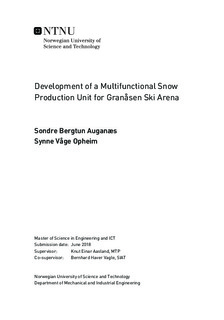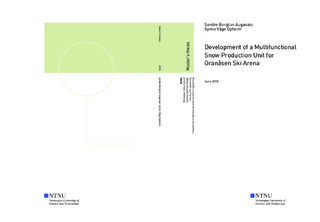| dc.description.abstract | Through the last decades, climate changes have drastically affected the winters in Norway. The implications of the climate changes are shorter winter seasons with increased temperatures, which makes snow production more relevant than ever before. One of the most important arenas for cross-country skiing in Trøndelag is Granåsen Ski Arena. This arena is essential for both recreational sports as well as international sports events. In Granåsen Ski Arena, the snow is usually produced in big piles and moved into the tracks afterward. This process is both time and energy consuming. For Granåsen Ski Arena to satisfy the future snow demands a new production system is needed. From the efficiency issues, the idea of the new, multifunctional and automated snow production unit located along the track arose. In this thesis, the development process of such a unit is started.
Automated snow production units exist today, but few are designed for narrow cross-country tracks. The focus of the development process has been to increase the efficiency of the snowmaking unit; by introducing automatic adjustment of the snow production, according to input data from weather stations. This approach offers the possibility of increasing the percentage of produced snow that fall within the tracks.
To be able to optimize the unit for narrow cross-country tracks, a model of the snow spray from lances is developed and used to test and refine concepts. Each sprayed water droplet has a size and an initial velocity. Euler's method is used to estimate the path and landing position of each droplet in different wind conditions. Analyses from this model show that adjustment of snow production is expedient at wind speeds up to about 5m/s. It also shows that a solution with fixed nozzles can obtain the same hit rates as a more complex solution with mobile nozzles.
Based on the results from prototyping with the analytic model, as well as interviews with experts, a design of a comprehensive, physical prototype has been proposed. The design has fixed nozzles at 7m height, divided into four horizontal orientations and two vertical steps. A guide to which nozzles should be used, depending on wind direction and wet-bulb temperature, has been proposed. | |

